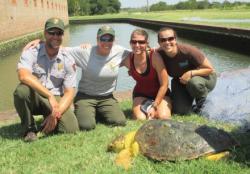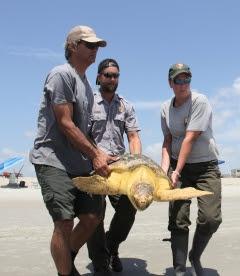Georgia DNR, Park Service Wrestle 80-pound Sea Turtle Out of Moat
from The Fishing Wire
Sea turtle work is more than cruising the beach and counting nests. There are bleary-eyed days that begin before dawn, sweaty work, swarms of insects, reams of data, crises so common they’re expected.
And there is the occasional first – like rescuing a loggerhead in a moat.
DNR Sea Turtle Program Coordinator Mark Dodd admits he didn’t want to get in the moat at Fort Pulaski. Fed by canal in a dike system reaching to the Savannah River, the nearly 200-year-old waterway is wide, up to 8 feet deep and “full of things” – pipework, rubble and, well, “you don’t know what’s in there,” Dodd said.
But the young loggerhead that fit through a pipe in the canal liked what was in there: lots of crabs.
Staff at Fort Pulaski National Monument, on Cockspur Island near Savannah, spotted the federally listed marine turtle and phoned Dodd. The loggerhead could likely survive until temperatures cooled in the fall. But, concerned that water quality might worsen, Dodd determined it was best to get it out now.
That’s when the how-to plans began to crumble. Draining the moat (something the National Park Service does occasionally) went too slowly and would have still left large pools. Plan B, using a canoe to drive the turtle toward a trammel fish net, also failed. The loggerhead saw the mesh and ducked away.
As a last resort, Dodd and former Georgia Sea Turtle Cooperative members Jen Kraus and Jessica Thompson, jumped in, stretched a seine net between them and slowly swam the turtle toward the trammel net, with help from the Park Service’s Candice Wyatt and Matt Hall.That worked, although lifting the crab-fattened, 80-pound reptile into the canoe and out of the moat was a challenge, what with the tangled net, squirming turtle and people falling out of the canoe. The extra muscle from the Park Service crew proved critical in getting the loggerhead over the moat wall.
Tagging and releasing the sea turtle off Tybee Island beach went smoother. Thankfully.
“Things happen and plans fall apart, and you just do what you gotta do,” Dodd said.
Even if it means getting in the moat.Did you know …
Built from 1829-1847 to protect Savannah from naval attack, Fort Pulaski was captured in fewer than 36 hours during a Union siege in April 1862. New rifled cannons fired from Tybee Island opened holes in the 7.5-foot-thick walls – two of the holes measured 30 feet wide – leading to the surrender.
Loggerhead sea turtles are on the brink of a nesting record in Georgia. Stay up-to-date on the counts. The number to beat: 2,289 nests documented in 2013.


